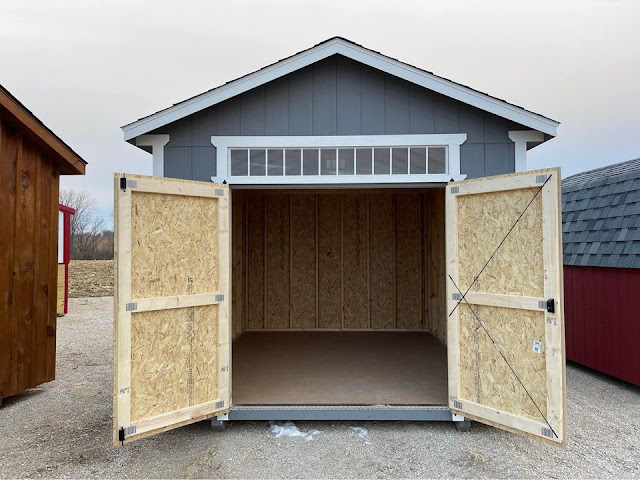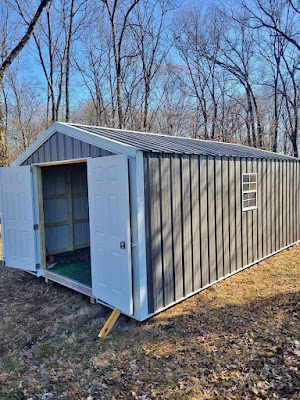Gable Shed Roof: Definition, Benefits, and Design
A gable shed roof is a popular roofing style for backyard sheds and small buildings. It features two sloping sides that meet at a peak or ridge in the middle, creating a triangular shape at each end. The gable shed roof has several benefits, including increased headroom, improved ventilation, and simple construction. In this article, we will discuss how to design, build, and maintain a gable shed roof.
Designing a Gable Shed Roof
When designing a gable shed roof, there are several factors to consider, such as the pitch and size of the roof, as well as the materials you will use. The pitch of the roof refers to the angle at which it slopes, and this will affect how much headroom you have inside the shed. The size of the roof will depend on the size of your shed and the amount of storage space you need. The materials you use will affect the durability, strength, and overall appearance of the roof.
Calculating the pitch and size of your gable shed roof can be done using various online calculators or with the help of a roofing contractor. You can also choose from a variety of roofing materials, such as asphalt shingles, metal panels, or cedar shakes, depending on your budget and preferences.
Building a Gable Shed Roof
Building a gable shed roof involves several steps, including preparing the roof framing, building the gable ends, installing the roof trusses, and adding the roof sheathing. The roof framing consists of the horizontal beams that form the frame of the roof, and the gable ends are the triangular portions that fill the space between the two sloping sides of the roof. The roof trusses are the angled beams that support the weight of the roof, and the roof sheathing is the material that covers the trusses and creates the flat surface of the roof.
It is important to ensure that the roof framing is level and square before building the gable ends and installing the trusses. The gable ends should be built with sturdy framing and properly flashed to prevent leaks. The roof trusses should be installed at the correct spacing and angles, and the roof sheathing should be securely fastened to the trusses to prevent it from being blown off by wind or other weather conditions.
Ventilation for Gable Shed Roofs
Proper ventilation is essential for gable shed roofs to prevent heat buildup, moisture accumulation, and mold growth. There are several types of ventilation options for gable shed roofs, including ridge vents, gable vents, and soffit vents. Ridge vents are installed at the peak of the roof and allow hot air to escape from the attic space, while gable vents are installed on the gable ends and allow fresh air to enter the attic space. Soffit vents are installed under the eaves of the roof and allow air to flow into the attic space from below.
When installing ventilation in a gable shed roof, it is important to ensure that the vents are properly sized, spaced, and installed to provide adequate airflow without compromising the structural integrity of the roof. You should also make sure that the vents are kept clean and free from debris to maintain optimal ventilation.
Maintenance and Repair of Gable Shed Roofs
Gable shed roofs are generally low-maintenance, but they still require periodic inspections and repairs to ensure their longevity and durability. Common issues with gable shed roofs include leaks, damage from fallen debris or branches, and wear and tear from weather conditions such as wind and rain.
To maintain your gable shed roof, you should inspect it regularly for signs of damage or wear, such as loose or missing shingles, cracked or warped roofing materials, or rusted or corroded flashing. You should also keep the roof clean and clear of debris, such as leaves and branches, to prevent clogs in the gutters and downspouts. If you notice any issues with your gable shed roof, it is important to address them promptly to prevent further damage.
Repairing a gable shed roof typically involves replacing damaged or worn materials, such as shingles or flashing, or sealing leaks with roofing cement or other sealants. For more extensive repairs, such as structural damage or major leaks, it is recommended to consult a professional roofing contractor.
Conclusion
A gable shed roof is a popular and practical roofing style for backyard sheds and small buildings. It offers several benefits, including increased headroom, improved ventilation, and simple construction. When designing and building a gable shed roof, it is important to consider factors such as the pitch and size of the roof, as well as the materials you will use. Proper ventilation and maintenance are also essential for the longevity and durability of the roof. With the right design, materials, and maintenance, a gable shed roof can provide reliable protection and functionality for many years to come.




Comments
Post a Comment